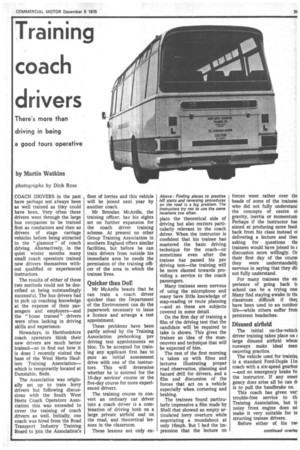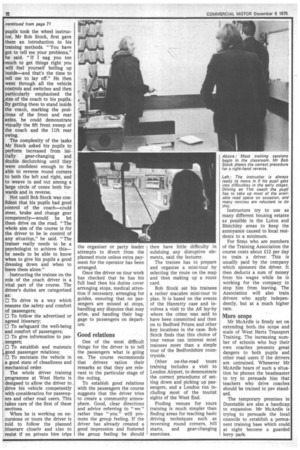Training coach drivers
Page 75

Page 76

If you've noticed an error in this article please click here to report it so we can fix it.
There's more than driving in being a good tours operative
by Martin Watkins
photographs by Dick Ross COACH DRIVERS in the past have perhaps not always been as well trained as they could have been. Very often these drivers went through the large bus companies to be trained first as conductors and then as drivers of stage carriage vehicles before being attracted to the " glamour " of coach driving. Alternatively, in the quiet winter months many small coach operators trained new drivers themselves without qualified or experienced instructors.
The results of either of these two methods could not be described as being outstandingly successful. The bus drivers had to pick up coaching knowledge at the expense of their passengers and employers—and the "home trained" drivers were often lacking in driving skills and experience.
Nowadays, in Hertfordshire coach operators think their new drivers are much better trained—so to find out how it is done I recently visited the base of the West Herts Hauliers Training Association— which is temporarily located at Dunstable, Beds.
The Association was originally set up to train lorry drivers but following discussions with the South West Herts Coach Operators Association this was extended to cover the training of coach drivers as well. Initially, one coach was hired from the Road Transport Industry Training Board to join the Association's fleet of lorries and this vehicle will be joined next year by another coach.
Mr Brendan McArdle, the training officer, has his sights set on further expansion for the coach driver training scheme. At present no other Group Training Association in southern England offers similar facilities, but before he can train drivers from outside his immediate area he needs the permission of the training officer of the area in which the trainee lives.
Quicker than DoE
Mr McArdle boasts that he can train a coach driver quicker than the Department of the Environment can do the paperwork necessary to issue a licence and arrange a test appointment.
These problems have been partly solved by the Training Association prebooking psv driving test appointments en bloc. To be accepted for training any applicant first has to pass an initial assessment drive with one of the instructors. This will determine whether he is entered for the 10-day novices' course or the five-day course for more experienced drivers.
The training course to convert an ordinary car driver into a coach driver is a combination of driving both on a large private airfield and on the road, and theoretical lessons in the classroom.
These lessons not only ex plain the theoretical side of driving but also matters particularly relevant to the coach driver. When the instructor is confident that his trainee has mastered the basic driving technique for the coach—or sometimes even after the trainee has passed his psv driving test—the training will be more slanted towards providing a service to the coach passengers.
Many trainees seem nervous of using the microphone and many have little knowledge of map-reading or route planning —and so these are subjects covered in some detail.
On the first day of training a film of the driving test that the candidate will be required to take is shown. This gives the trainee an idea of the manoeuvres and technique that will be expected of him.
The rest of the first morning is taken up with films and lectures illustrating proper road observation, planning and hazard drill for drivers, and a film and discussion of the forces that act on a vehicle especially when cornering and braking.
The trainees found particularly impressive a film made by Shell that showed an empty articulated lorry overturn while negotiating a roundabout at only I6mph. But I had the impression that the lecture on forces went rather over tht heads of some of the trainee: who did not fully understani the concepts of centre 01 gravity, inertia or momentum Perhaps if the instructor hat aimed at producing more feed. back from his class instead oi delivering a lecture and ther asking for questions thf trainees would have joined in c discussion more willingly. Or their first day of the coursc they were understandabl5 nervous in saying that they dic not fully understand.
For many trainees the ex perience of going back tc school can be a trying one Many find staying awake in tin classroom difficult if the5 have been used to an outdoce life—while others suffer fron persistent headaches.
Disused airfield
The initial on-the-vehich driver training takes place on I large disused airfield whosi runways make ideal man oeuvring practice.
The vehicle used for trainini is a standard Ford-Duple ha coach with a six-speed gearboa —and no emergency brake fo the instructor. If any emer gency does arise all he can c14 is to pull the handbrake on.
This coach has given ver: trouble-free service to ail Training Association, but it noisy front engine does no make it very suitable for in structing trainee drivers.
Before either of his tw4 pupils took the wheel instructor, Mr Bob Stock, first gave them an introduction to his training methods. "You have got to tell me your problems," he said. " If I nag you too 'much to get things right you will feel yourself boiling up inside—and that's the time to tell me to lay off." He then went through all the vehicle controls and switches and then particularly emphasised the , size of the coach to his pupils. By getting them to stand inside the coach, marking the posi,tions of the front and rear axles, he could demonstrate visually the 8ft front sweep of the coach and the lift rear swing.
The complexity of the tasks Mr Stock asked his pupils to perform increased from initially gear-changing and double declutching until they were confident enough to be able to reverse round corners to both the left and right, and to weave in and out among a large circle of cones both forwards and in reverse.
Not until Bob Stock was confident that his pupils had good control of the coach—could steer, brake and change gear competently—would he let them drive on the road. "The whole aim of the course is for the driver to be in control of any situation," he said. "The trainer really needs to be a psychologist to achieve this— he needs to be able to know when to give his pupils a good dressing down and when to leave them alone."
Instructing the trainee on the role of the coach driver is a vital part of the course. The driver's duties are categorised as: 1=1 To drive in a way which ensures the safety and comfort of passengers; ID To follow the advertised or agreed itinerary; 0 To safeguard the well-being and comfort of passengers; 1 O To give information to passengers; I=1 To establish and maintain good passenger relations; 0 To maintain the vehicle in a good state of cleanliness and mechanical order.
The whole driver training programme at West Hefts is designed to allow the driver to. drive his vehicle competently with consideration for passengers and other road users. This takes care of the first of these sections.
When he is working on excursions or tours the driver is told to follow the planned itinerary closely and also to , resist if on private hire trips the organiser or party leader attempts to divert from the planned route unless extra payment for the operator has been arranged.
Once the driver on tour work has checked that he has his full load then his duties cover arranging stops, medical attention if necessary, arranging for guides, ensuring that no passengers are missed at stops, handling any disputes that may arise, and handing their baggage to passengers on departure.
Good relations
One of the most difficult things for the driver is to tell the passengers what is going on. The course recommends that drivers ration their remarks so that they are relevant to the particular stage of the outing.
To estabish good relations with the passengers the course suggests that the driver tries to create a community atmosphere. Good, clear directions and advice referring to " we " rather than " you " will promote the group feeling. If the driver has already created a good impression and fostered the group feeling he should then have little difficulty in subduing any disruptive elements, said the lecturer.
The trainee has to prepare and organise a mini-tour by selecting the route on the map and then making up a route card.
Bob Stock set his trainees a rather macabre mini-tour to plan. It is based on the events of the Hanratty case and involves a visit to the A6 lay-by where the crime was said to have been committed and then on to Bedford Prison and other key locations in the case. Bob Stock finds that this choice of tour venue can interest most trainees more than a simple tour of the Bedfordshire countryside.
Other on-the-road tours training includes a visit to London Airport, to demonstrate the correct procedures of setting down and picking up passengers, and a London run including most of the tourist sights of the West End.
Finding venues for tours training is much simpler than finding areas for teaching basic driving techniques such as reversing round corners, hill starts, and gear-changing exercises. Instructors try to use as many different housing estates as possible in the Luton and Bletchley areas to keep the annoyance caused to local residents to a minimum.
For firms who are members of the Training Association the course costs about £12 per day to train a driver. This is usually paid by the company which sponsors the driver. It then deducts a sum of money from his wages while he is working for the company to stop him from leaving. The Association will also train drivers who apply independently, but at a much higher rate.
More scope
Mr McArdle is firmly set on extending both,, the scope and scale of West Hefts Transport Training. The increasing number of schools who buy their own coaches presents great dangers to both pupils and other road users if the drivers are untrained. Whenever Mr McArdle hears of such a situation he phones the headmaster to try to persuade him that teachers who drive coaches should be trained to pp/ standard.
The temporary premises in Dunstable are also a handicap to expansion. Mr McArdle is trying to persuade the local councils to establish a permanent training base which could at night become a guarded lorry park.


































































































































